Detailed Analysis of the Copyright Amendment Act 2006 and Implications
VerifiedAdded on 2020/03/04
|5
|960
|57
Report
AI Summary
This report provides an analysis of the Copyright Amendment Act 2006, examining its impact on software copyright, technological protection measures, and digital media. The report discusses the Act's amendments to the 1968 Act, including the introduction of the Copyright Tribunal, criminal penalties, and technological protection measures. It also explores the Act's focus on digital media and its encouragement of international technical standards. The report highlights the need for organizations to understand and implement the Act's provisions, including internal policies and employee training, to ensure compliance and protect their software programs. The author recommends extending the law to address specific issues in software development and use, advocating for global harmonization of copyright laws through international treaties. The report emphasizes the importance of copyright protection in the IT environment and the need for the law to adapt to changing consumer behavior and technological advancements.
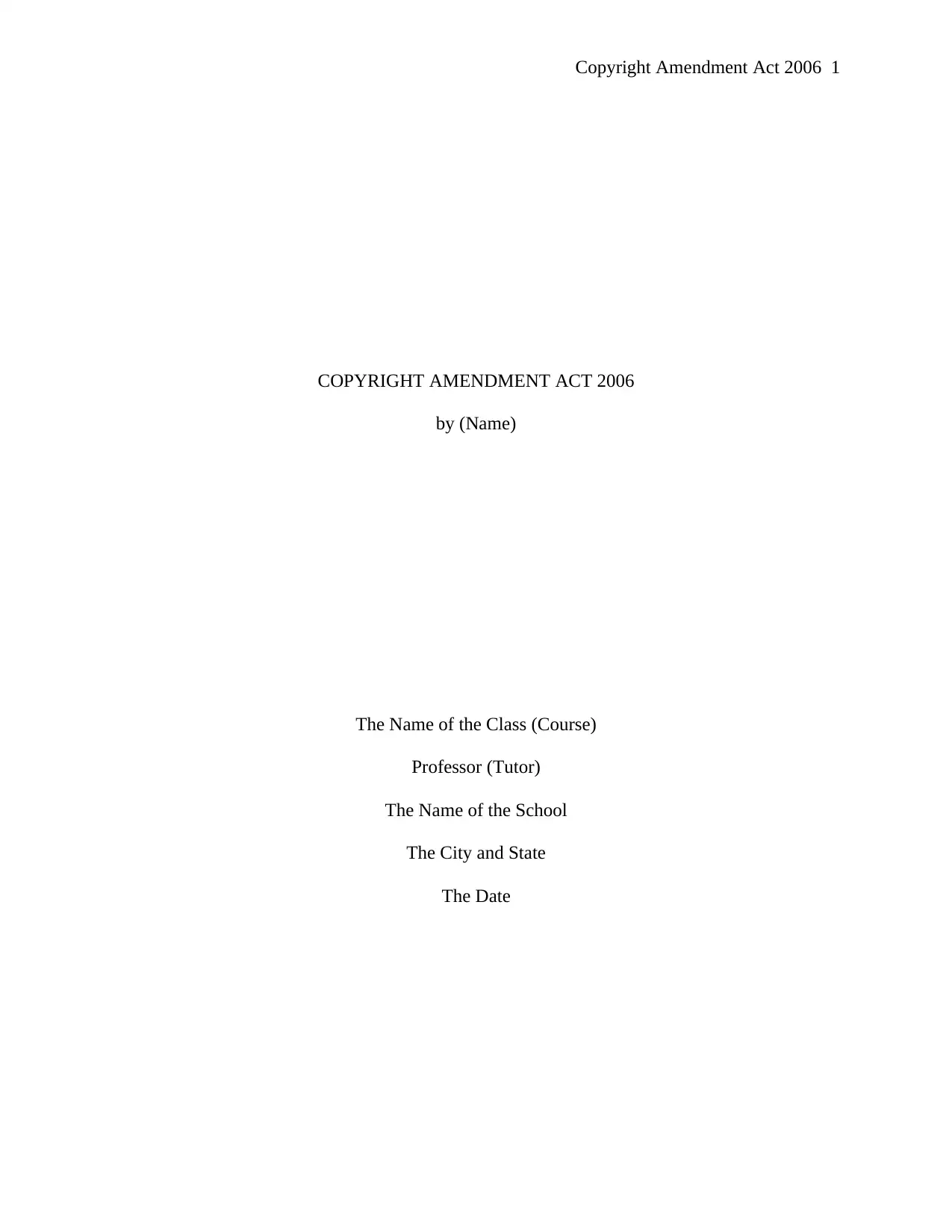
Copyright Amendment Act 2006 1
COPYRIGHT AMENDMENT ACT 2006
by (Name)
The Name of the Class (Course)
Professor (Tutor)
The Name of the School
The City and State
The Date
COPYRIGHT AMENDMENT ACT 2006
by (Name)
The Name of the Class (Course)
Professor (Tutor)
The Name of the School
The City and State
The Date
Paraphrase This Document
Need a fresh take? Get an instant paraphrase of this document with our AI Paraphraser
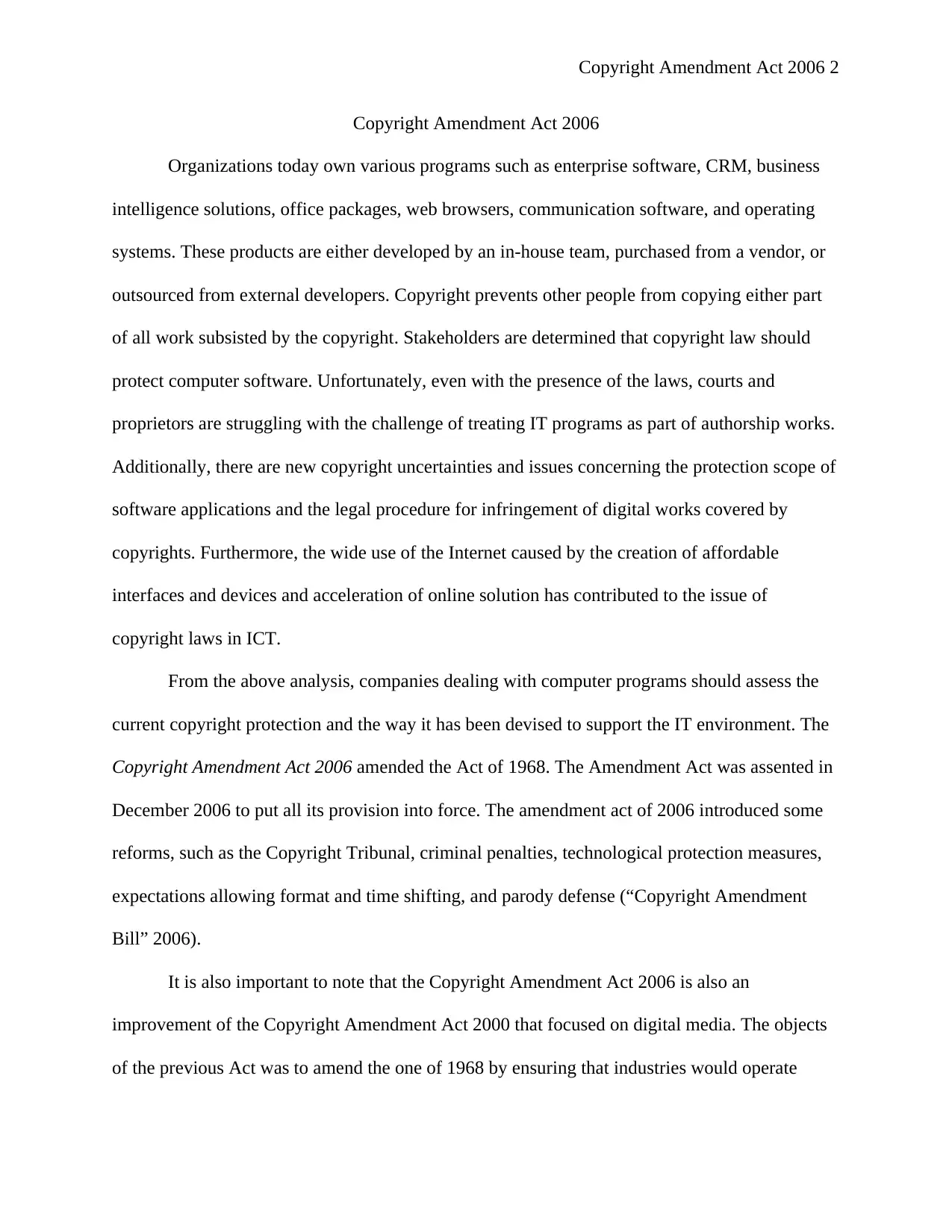
Copyright Amendment Act 2006 2
Copyright Amendment Act 2006
Organizations today own various programs such as enterprise software, CRM, business
intelligence solutions, office packages, web browsers, communication software, and operating
systems. These products are either developed by an in-house team, purchased from a vendor, or
outsourced from external developers. Copyright prevents other people from copying either part
of all work subsisted by the copyright. Stakeholders are determined that copyright law should
protect computer software. Unfortunately, even with the presence of the laws, courts and
proprietors are struggling with the challenge of treating IT programs as part of authorship works.
Additionally, there are new copyright uncertainties and issues concerning the protection scope of
software applications and the legal procedure for infringement of digital works covered by
copyrights. Furthermore, the wide use of the Internet caused by the creation of affordable
interfaces and devices and acceleration of online solution has contributed to the issue of
copyright laws in ICT.
From the above analysis, companies dealing with computer programs should assess the
current copyright protection and the way it has been devised to support the IT environment. The
Copyright Amendment Act 2006 amended the Act of 1968. The Amendment Act was assented in
December 2006 to put all its provision into force. The amendment act of 2006 introduced some
reforms, such as the Copyright Tribunal, criminal penalties, technological protection measures,
expectations allowing format and time shifting, and parody defense (“Copyright Amendment
Bill” 2006).
It is also important to note that the Copyright Amendment Act 2006 is also an
improvement of the Copyright Amendment Act 2000 that focused on digital media. The objects
of the previous Act was to amend the one of 1968 by ensuring that industries would operate
Copyright Amendment Act 2006
Organizations today own various programs such as enterprise software, CRM, business
intelligence solutions, office packages, web browsers, communication software, and operating
systems. These products are either developed by an in-house team, purchased from a vendor, or
outsourced from external developers. Copyright prevents other people from copying either part
of all work subsisted by the copyright. Stakeholders are determined that copyright law should
protect computer software. Unfortunately, even with the presence of the laws, courts and
proprietors are struggling with the challenge of treating IT programs as part of authorship works.
Additionally, there are new copyright uncertainties and issues concerning the protection scope of
software applications and the legal procedure for infringement of digital works covered by
copyrights. Furthermore, the wide use of the Internet caused by the creation of affordable
interfaces and devices and acceleration of online solution has contributed to the issue of
copyright laws in ICT.
From the above analysis, companies dealing with computer programs should assess the
current copyright protection and the way it has been devised to support the IT environment. The
Copyright Amendment Act 2006 amended the Act of 1968. The Amendment Act was assented in
December 2006 to put all its provision into force. The amendment act of 2006 introduced some
reforms, such as the Copyright Tribunal, criminal penalties, technological protection measures,
expectations allowing format and time shifting, and parody defense (“Copyright Amendment
Bill” 2006).
It is also important to note that the Copyright Amendment Act 2006 is also an
improvement of the Copyright Amendment Act 2000 that focused on digital media. The objects
of the previous Act was to amend the one of 1968 by ensuring that industries would operate
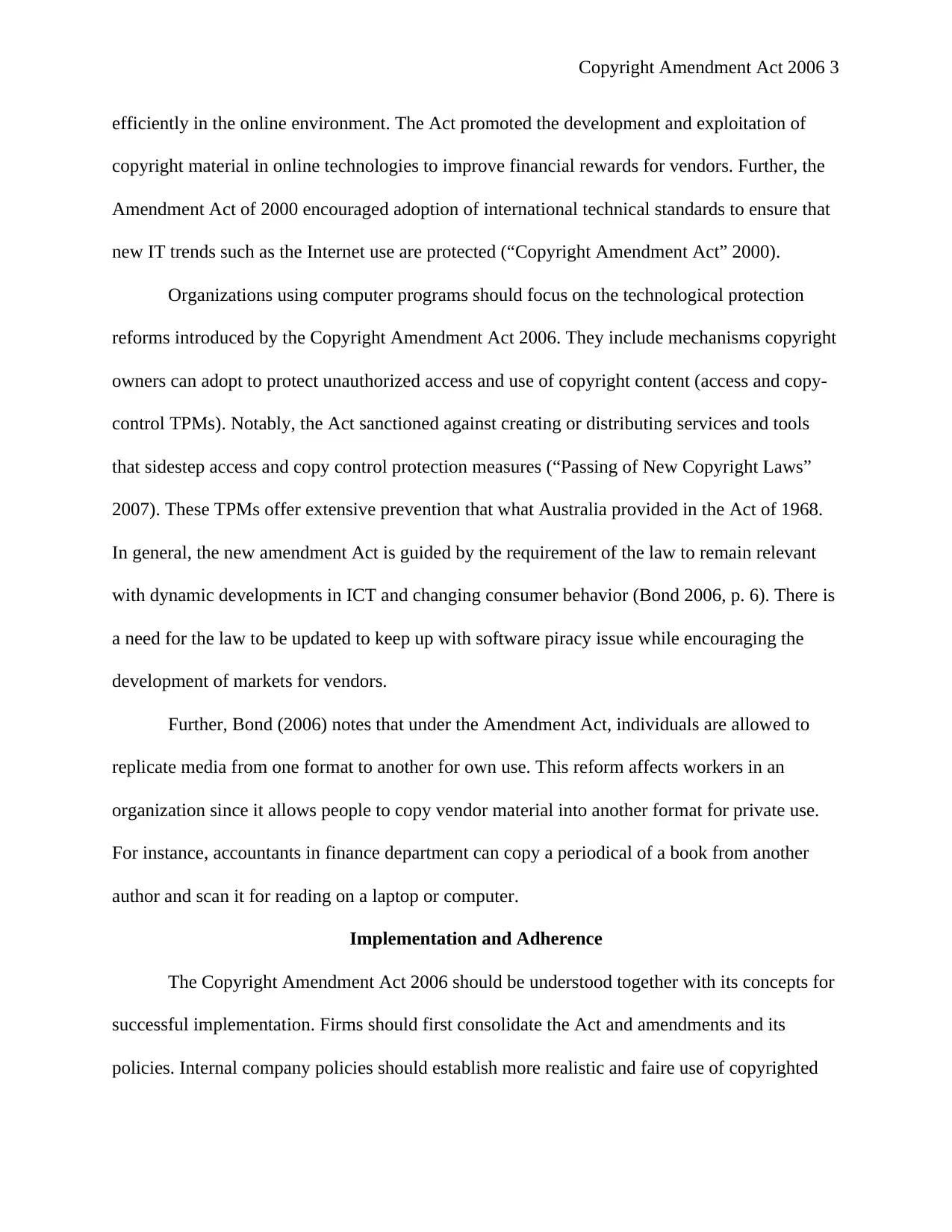
Copyright Amendment Act 2006 3
efficiently in the online environment. The Act promoted the development and exploitation of
copyright material in online technologies to improve financial rewards for vendors. Further, the
Amendment Act of 2000 encouraged adoption of international technical standards to ensure that
new IT trends such as the Internet use are protected (“Copyright Amendment Act” 2000).
Organizations using computer programs should focus on the technological protection
reforms introduced by the Copyright Amendment Act 2006. They include mechanisms copyright
owners can adopt to protect unauthorized access and use of copyright content (access and copy-
control TPMs). Notably, the Act sanctioned against creating or distributing services and tools
that sidestep access and copy control protection measures (“Passing of New Copyright Laws”
2007). These TPMs offer extensive prevention that what Australia provided in the Act of 1968.
In general, the new amendment Act is guided by the requirement of the law to remain relevant
with dynamic developments in ICT and changing consumer behavior (Bond 2006, p. 6). There is
a need for the law to be updated to keep up with software piracy issue while encouraging the
development of markets for vendors.
Further, Bond (2006) notes that under the Amendment Act, individuals are allowed to
replicate media from one format to another for own use. This reform affects workers in an
organization since it allows people to copy vendor material into another format for private use.
For instance, accountants in finance department can copy a periodical of a book from another
author and scan it for reading on a laptop or computer.
Implementation and Adherence
The Copyright Amendment Act 2006 should be understood together with its concepts for
successful implementation. Firms should first consolidate the Act and amendments and its
policies. Internal company policies should establish more realistic and faire use of copyrighted
efficiently in the online environment. The Act promoted the development and exploitation of
copyright material in online technologies to improve financial rewards for vendors. Further, the
Amendment Act of 2000 encouraged adoption of international technical standards to ensure that
new IT trends such as the Internet use are protected (“Copyright Amendment Act” 2000).
Organizations using computer programs should focus on the technological protection
reforms introduced by the Copyright Amendment Act 2006. They include mechanisms copyright
owners can adopt to protect unauthorized access and use of copyright content (access and copy-
control TPMs). Notably, the Act sanctioned against creating or distributing services and tools
that sidestep access and copy control protection measures (“Passing of New Copyright Laws”
2007). These TPMs offer extensive prevention that what Australia provided in the Act of 1968.
In general, the new amendment Act is guided by the requirement of the law to remain relevant
with dynamic developments in ICT and changing consumer behavior (Bond 2006, p. 6). There is
a need for the law to be updated to keep up with software piracy issue while encouraging the
development of markets for vendors.
Further, Bond (2006) notes that under the Amendment Act, individuals are allowed to
replicate media from one format to another for own use. This reform affects workers in an
organization since it allows people to copy vendor material into another format for private use.
For instance, accountants in finance department can copy a periodical of a book from another
author and scan it for reading on a laptop or computer.
Implementation and Adherence
The Copyright Amendment Act 2006 should be understood together with its concepts for
successful implementation. Firms should first consolidate the Act and amendments and its
policies. Internal company policies should establish more realistic and faire use of copyrighted
⊘ This is a preview!⊘
Do you want full access?
Subscribe today to unlock all pages.

Trusted by 1+ million students worldwide
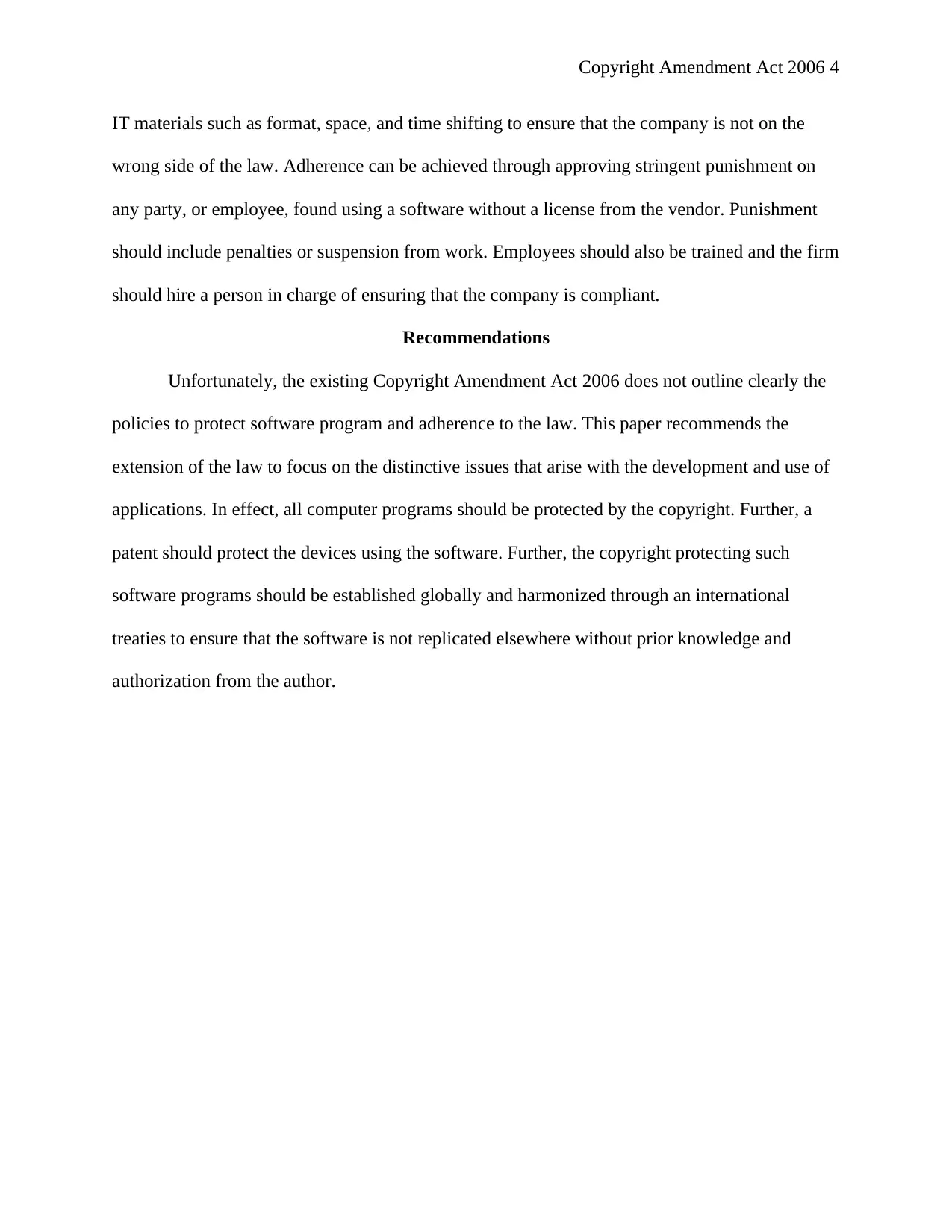
Copyright Amendment Act 2006 4
IT materials such as format, space, and time shifting to ensure that the company is not on the
wrong side of the law. Adherence can be achieved through approving stringent punishment on
any party, or employee, found using a software without a license from the vendor. Punishment
should include penalties or suspension from work. Employees should also be trained and the firm
should hire a person in charge of ensuring that the company is compliant.
Recommendations
Unfortunately, the existing Copyright Amendment Act 2006 does not outline clearly the
policies to protect software program and adherence to the law. This paper recommends the
extension of the law to focus on the distinctive issues that arise with the development and use of
applications. In effect, all computer programs should be protected by the copyright. Further, a
patent should protect the devices using the software. Further, the copyright protecting such
software programs should be established globally and harmonized through an international
treaties to ensure that the software is not replicated elsewhere without prior knowledge and
authorization from the author.
IT materials such as format, space, and time shifting to ensure that the company is not on the
wrong side of the law. Adherence can be achieved through approving stringent punishment on
any party, or employee, found using a software without a license from the vendor. Punishment
should include penalties or suspension from work. Employees should also be trained and the firm
should hire a person in charge of ensuring that the company is compliant.
Recommendations
Unfortunately, the existing Copyright Amendment Act 2006 does not outline clearly the
policies to protect software program and adherence to the law. This paper recommends the
extension of the law to focus on the distinctive issues that arise with the development and use of
applications. In effect, all computer programs should be protected by the copyright. Further, a
patent should protect the devices using the software. Further, the copyright protecting such
software programs should be established globally and harmonized through an international
treaties to ensure that the software is not replicated elsewhere without prior knowledge and
authorization from the author.
Paraphrase This Document
Need a fresh take? Get an instant paraphrase of this document with our AI Paraphraser
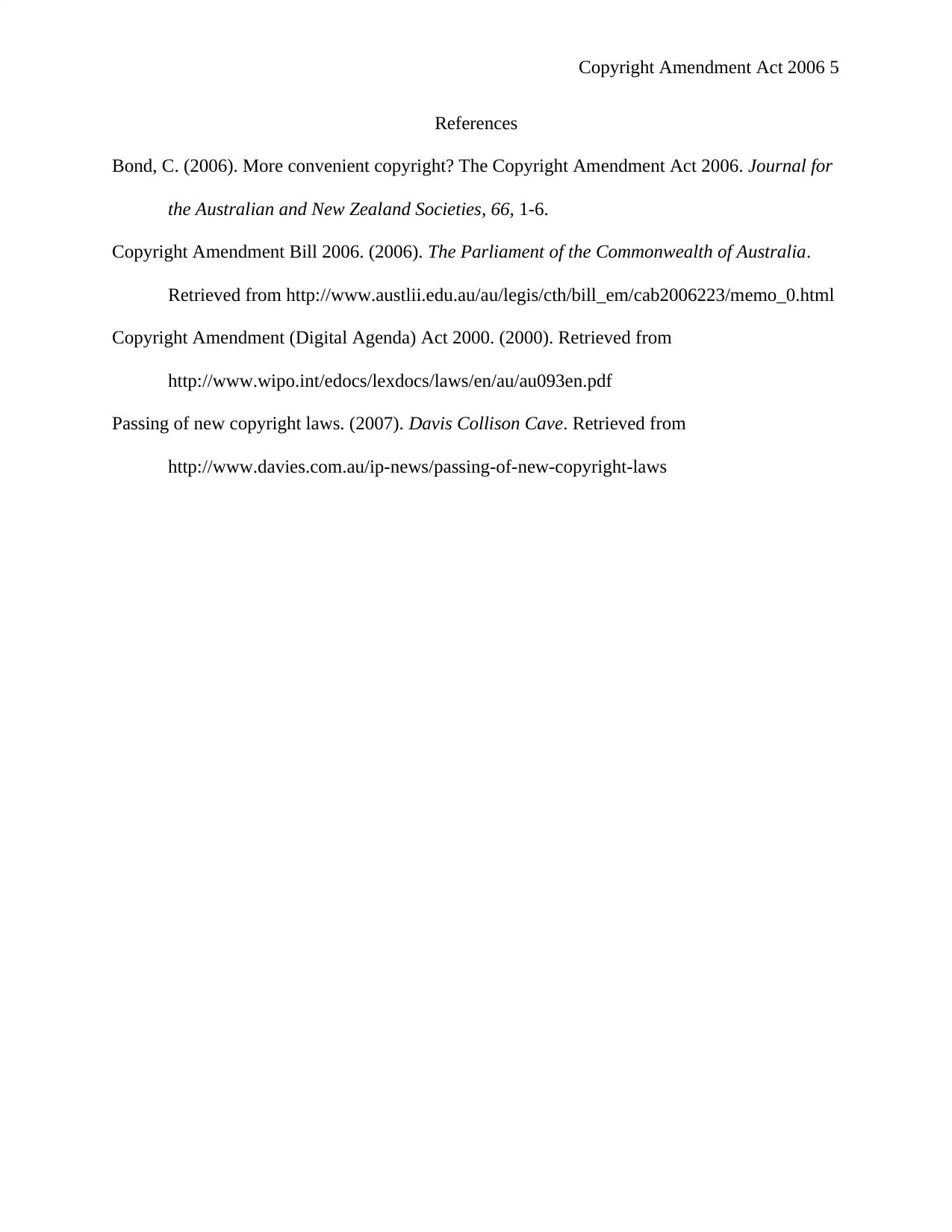
Copyright Amendment Act 2006 5
References
Bond, C. (2006). More convenient copyright? The Copyright Amendment Act 2006. Journal for
the Australian and New Zealand Societies, 66, 1-6.
Copyright Amendment Bill 2006. (2006). The Parliament of the Commonwealth of Australia.
Retrieved from http://www.austlii.edu.au/au/legis/cth/bill_em/cab2006223/memo_0.html
Copyright Amendment (Digital Agenda) Act 2000. (2000). Retrieved from
http://www.wipo.int/edocs/lexdocs/laws/en/au/au093en.pdf
Passing of new copyright laws. (2007). Davis Collison Cave. Retrieved from
http://www.davies.com.au/ip-news/passing-of-new-copyright-laws
References
Bond, C. (2006). More convenient copyright? The Copyright Amendment Act 2006. Journal for
the Australian and New Zealand Societies, 66, 1-6.
Copyright Amendment Bill 2006. (2006). The Parliament of the Commonwealth of Australia.
Retrieved from http://www.austlii.edu.au/au/legis/cth/bill_em/cab2006223/memo_0.html
Copyright Amendment (Digital Agenda) Act 2000. (2000). Retrieved from
http://www.wipo.int/edocs/lexdocs/laws/en/au/au093en.pdf
Passing of new copyright laws. (2007). Davis Collison Cave. Retrieved from
http://www.davies.com.au/ip-news/passing-of-new-copyright-laws
1 out of 5
Related Documents
Your All-in-One AI-Powered Toolkit for Academic Success.
+13062052269
info@desklib.com
Available 24*7 on WhatsApp / Email
![[object Object]](/_next/static/media/star-bottom.7253800d.svg)
Unlock your academic potential
Copyright © 2020–2025 A2Z Services. All Rights Reserved. Developed and managed by ZUCOL.




